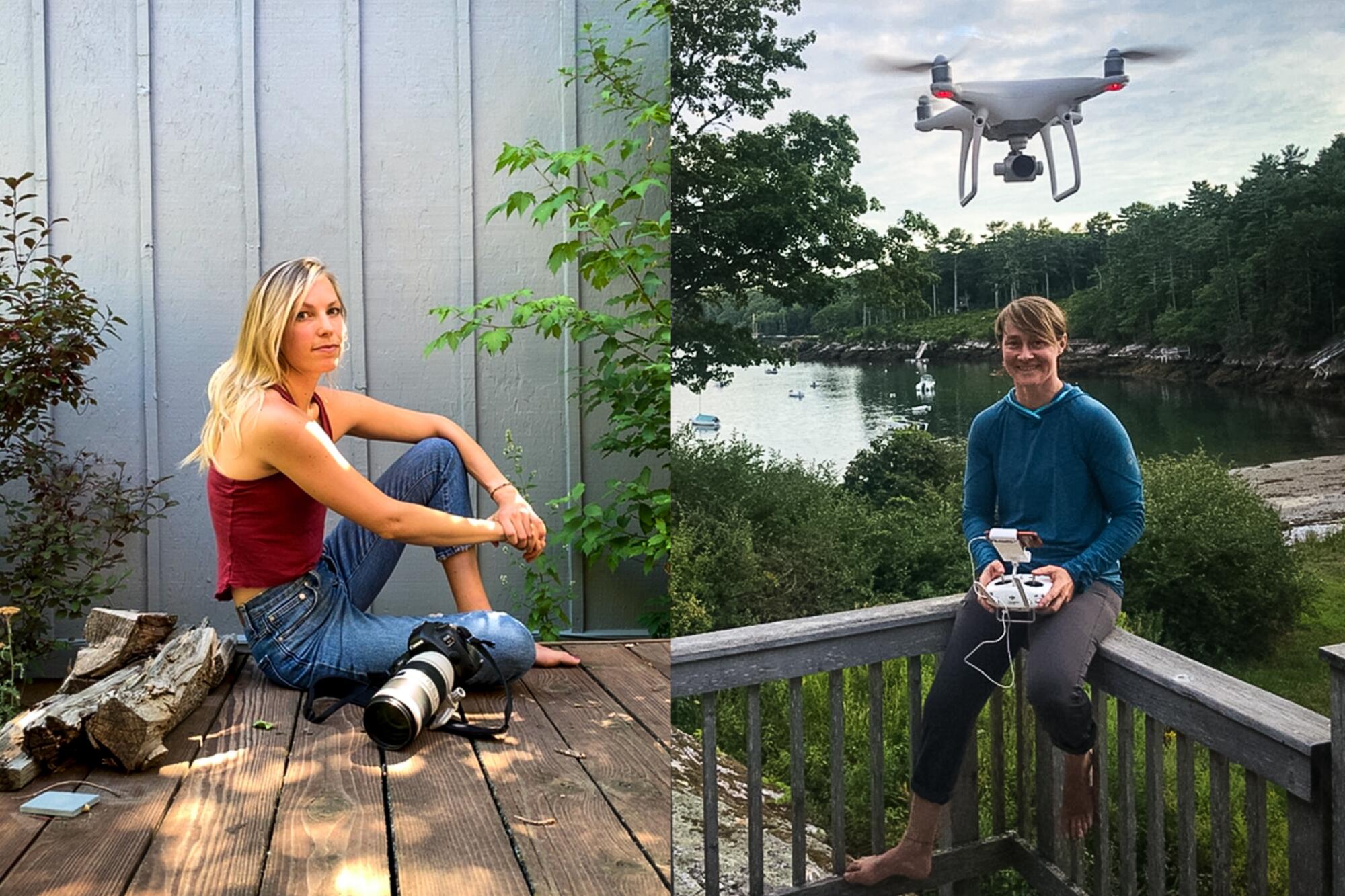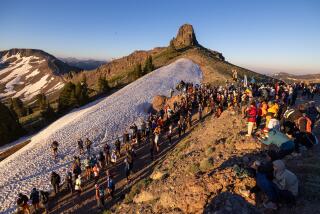
- Share via
Eliza Earle twisted her ankle for the umpteenth time while filming “World’s Toughest Race: Eco-Challenge Fiji.” Though it was nearly midnight, the 30-year-old adventurer resolved to hike the few remaining miles of muddy trail to the campsite, where she’d wrap her ankle, clean her gear, restock on provisions and scarf down some food and water before getting back out on the course for another 24 hours or so.
The show’s producer thought otherwise, urging her to take a real break and get clearance from medical to continue. Unlike those competing in the race, Earle was weathering the extreme heat, steep terrain and sleep deprivation while on the job — as a camera operator of the uniquely demanding reality series.
“I was so upset because I’ve been with that team the whole way there,” Earle told The Times of Team Atenah Brasil, which was assigned another crew member while she rested for 12 hours. “You get really attached to your team that you kind of feel like you’re one of them as well.”
“World’s Toughest Race: Eco-Challenge Fiji” — all 10 episodes of which are now streaming on Amazon Prime Video — is a reboot of Mark Burnett’s expedition race, which was inspired by a Times article and aired from 1995 to 2002. Hosted by Bear Grylls, this “Eco-Challenge” sees a record 66 four-person teams from 30 countries attempting to traverse more than 400 miles in less than 11 days — without the use of navigational electronics.
The large-scale production required 200-plus cameras to collect 1,350 hours of footage in 4K and HDR, with the help of drones and tracking devices. But the real appeal of these on-screen adventures hinges on competitors’ battles with the elements, each other and their own physical and mental limits — intimate moments that had to be captured by Earle and 11 other embedded camera operators.
“They’re as much athletes as they are camera operators, because they have to be able to handle the environment just like the athletes do,” said showrunner Lisa Hennessy, who worked on all of the original “Eco-Challenge” installments. “The racecourse is specifically designed to test people in a certain way. So as the teams were testing themselves past whatever they thought was possible, so were our crew.”
The “Special Ops,” as they were called, first had to rate themselves on their abilities in activities like rope climbing, jungle trekking, mountain biking, river rafting and hiking. “I wish every job application was like that, because that’s all the stuff I love to do,” said camera operator Kathryn Barrows, 43. “I felt like this is the show I’ve been waiting my whole life to shoot.”
Barrows, who previously worked on the National Geographic series “Continent 7: Antarctica,” trained for the gig for two months by taking long-distance hikes around Maine, where she spent her childhood summers. She regularly veered off trails and trekked along streams, wearing weights to replicate the camping supplies and filming equipment she’d carry. To simulate the camera, “I brought a 5-pound dumbbell around whenever I would hike or do hill sprints. I wanted to get used to that feeling of always having that weight in my hand, and make it an extension of me.”
Earle, an assistant producer on the rock-climbing documentary “The Dawn Wall,” spent three months running trails in the French Alps for seven hours a day with her sister, and completed the Tour du Mont Blanc in under five days. “I felt so ridiculous with this big running vest stuffed with all these water bottles, and a bunch of my cameras and lenses strapped to my hips,” she recalled. “I was like, ‘Well, it’s not comfortable, but it’ll work.’”
The “Special Ops” were tasked with filming 20 teams, which were selected in some cases for their country of origin or distinct back story rather than their front-of-the-pack ambitions: for example, Team Onyx, the first entirely African American adventure racing team in a global competition; Team Khukuri Warriors, led by 23-year-old twin sisters from India; and Team Endure, which included a player afflicted with early-onset Alzheimer’s disease. (The show pulls back the curtain on how it monitors the competitors inside “Race HQ,” which was “a tent getting blown over by the wind half the time” in previous seasons, said Hennessy.)
Camera operators traveled alongside the teams through jungles, rivers, swamps and mountains, withstanding conditions like harsh rains, unrelenting humidity and the threat of hypothermia without complaint. If the competitors you’re following got lost, you got lost right along with them, circling the same area for hours. Sleep was anything but guaranteed: “You don’t know when it’ll be, so you basically just take it when you can get it,” said Barrows with a laugh.
When switching between subjects, the crew were relocated by car, boat or helicopter as much as possible. But sometimes they just had to get themselves in or out of a remote location on their own, which might mean waiting for weather conditions to clear until it was safe to do so. That’s what happened at Vuwa Falls, where some camera crew remained unretrieved by helicopter for three days due to impenetrable cloud cover.
“They were completely safe and had plenty of food and water, but from a coverage point of view, you’re down two or three operators,” said Hennessy. “That’s just what happens when you film in these amazing places in the wilderness — there isn’t access a lot of the time because it’s so extreme.”
“The outdoor adventure community calls this Type II Fun, the type of fun where you don’t realize it was fun until after it’s over because it’s grueling while you’re in it,” added Earle. “We’re storytellers by trade, but we’re also athletes, and we’re used to being in uncomfortable situations and being totally OK with it.”
Thankfully, production wrapped without any major behind-the-scenes snafus. Barrows and Earle returned to their regular lives: Barrows headed out to another gig, and Earle embarked on a two-week camping trip in the Utah desert.
Both would love to take part in a future “Eco-Challenge” season, even if they’re again the only female embedded camera operators on the large-scale project. “Sometimes I feel like I’m constantly having to prove myself not just as a capable camera operator, but also that I can carry all the weight and still keep up and even run as fast as anyone else,” said Earle.
“Our team of embedded camera operators was a bunch of gnarly mountain men, three or four of whom summited Everest! Feeling super confident in this space takes time, and I’ve gotten to a point where I know that if I get hired for a job like this, I can do it.”
“It is a male-dominated industry, but it’s changing,” added Barrows. “I hope more women will be inspired to see what it’s all about, join the industry and even it out a little bit.”
‘World’s Toughest Race: Eco-Challenge Fiji’
Where: Amazon Prime
When: Any time, starting Friday, Aug. 14
Rated: TV-14 (may be unsuitable for children under the age of 14)
More to Read
The complete guide to home viewing
Get Screen Gab for everything about the TV shows and streaming movies everyone’s talking about.
You may occasionally receive promotional content from the Los Angeles Times.







